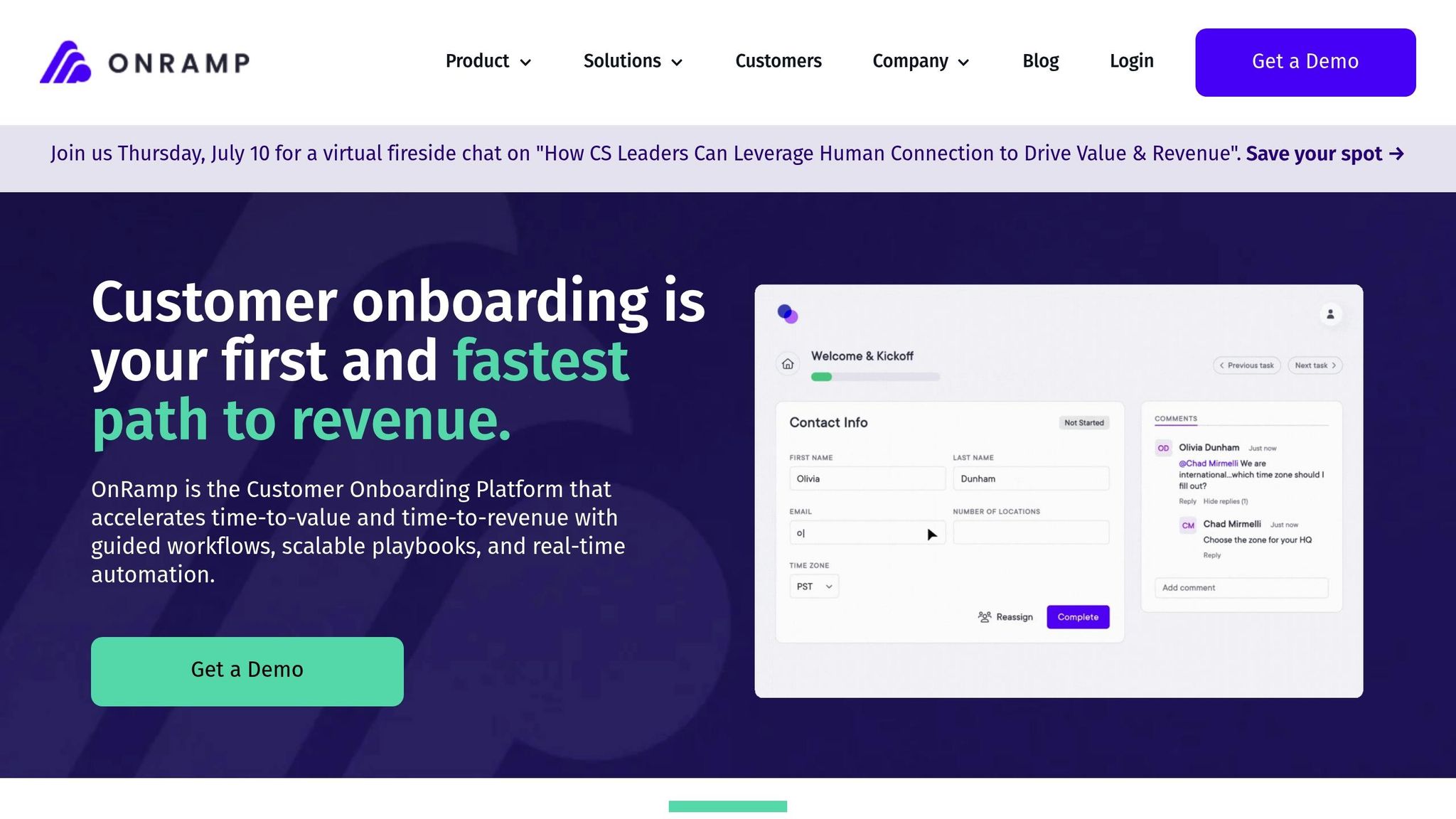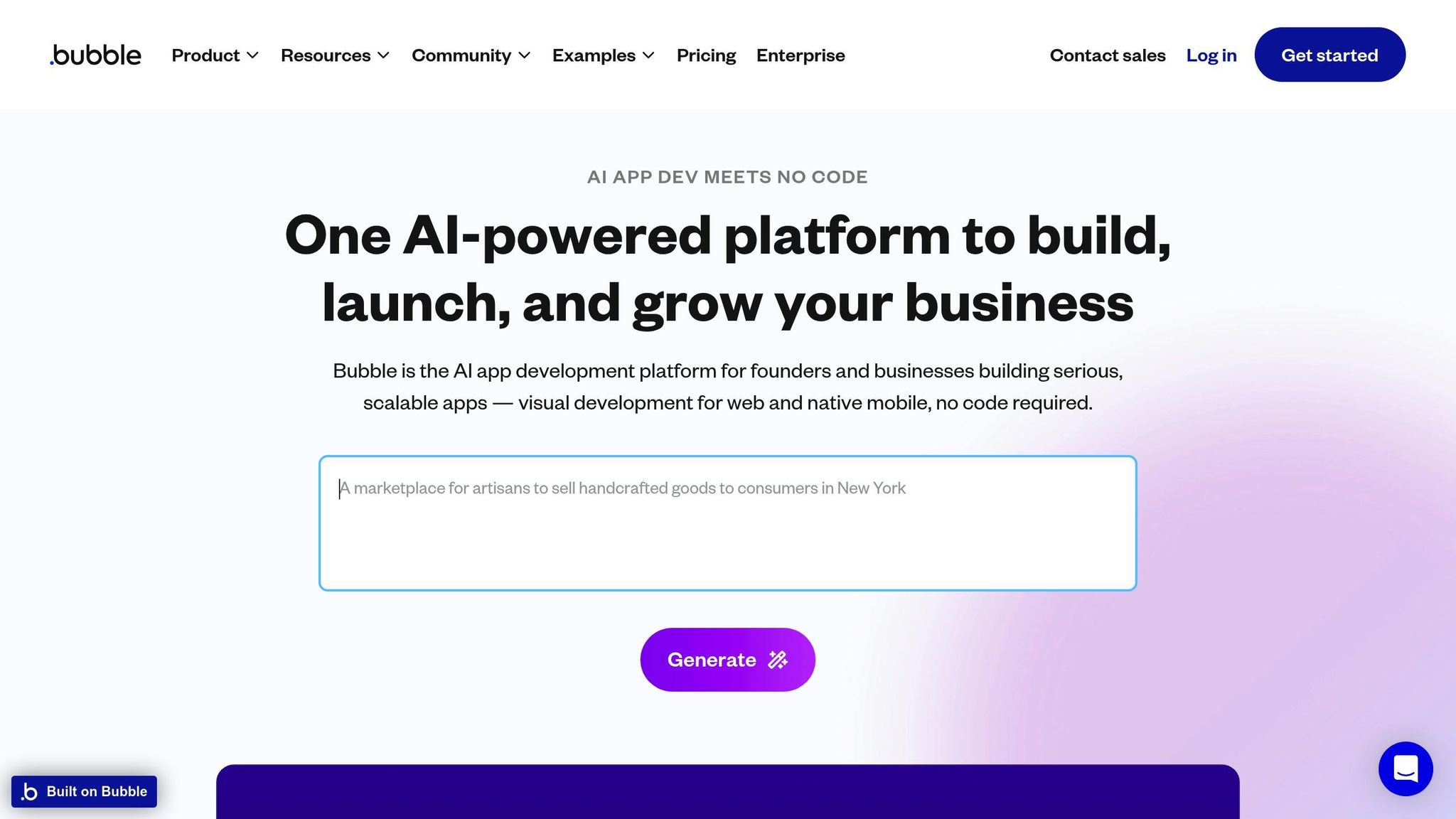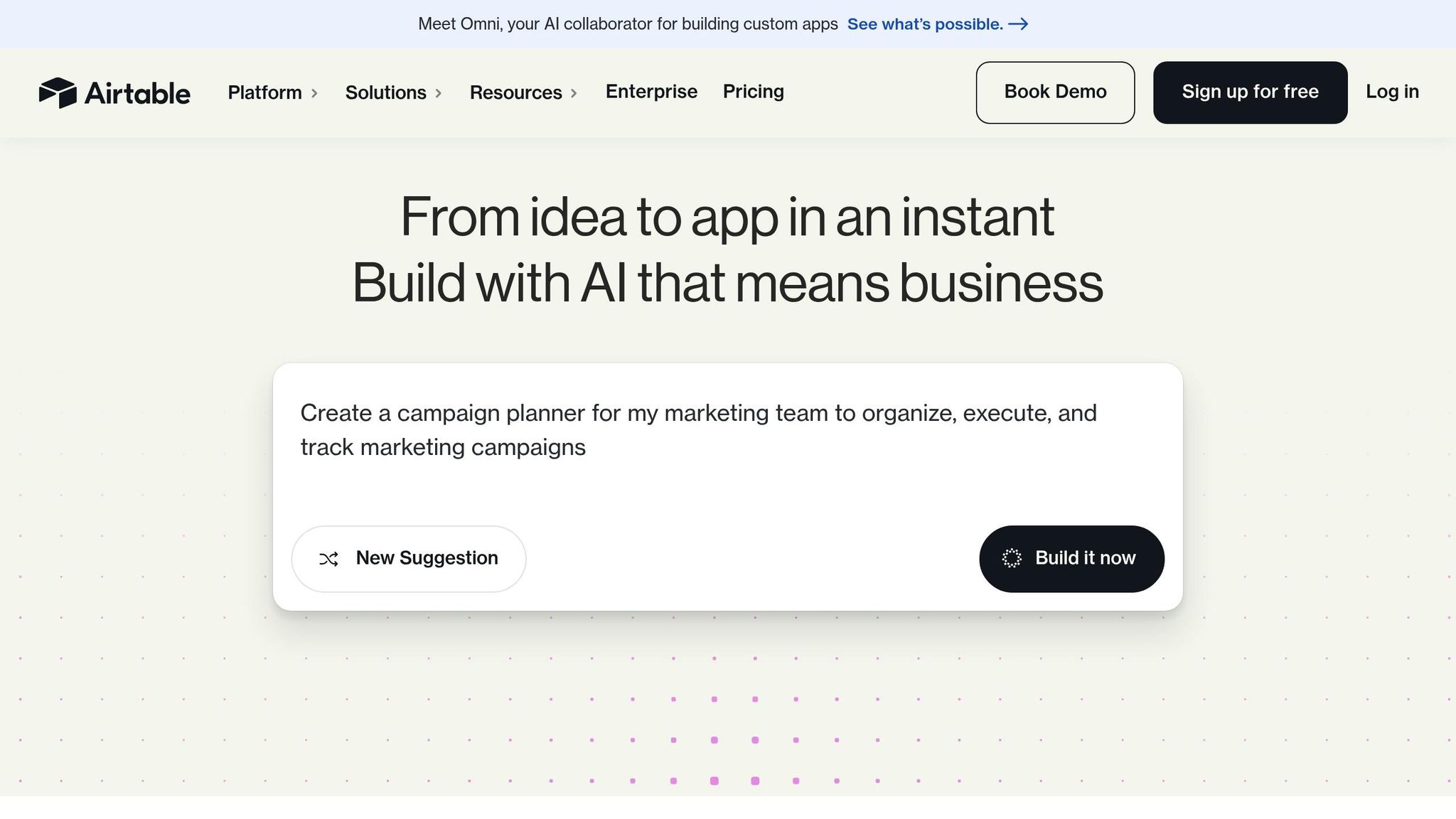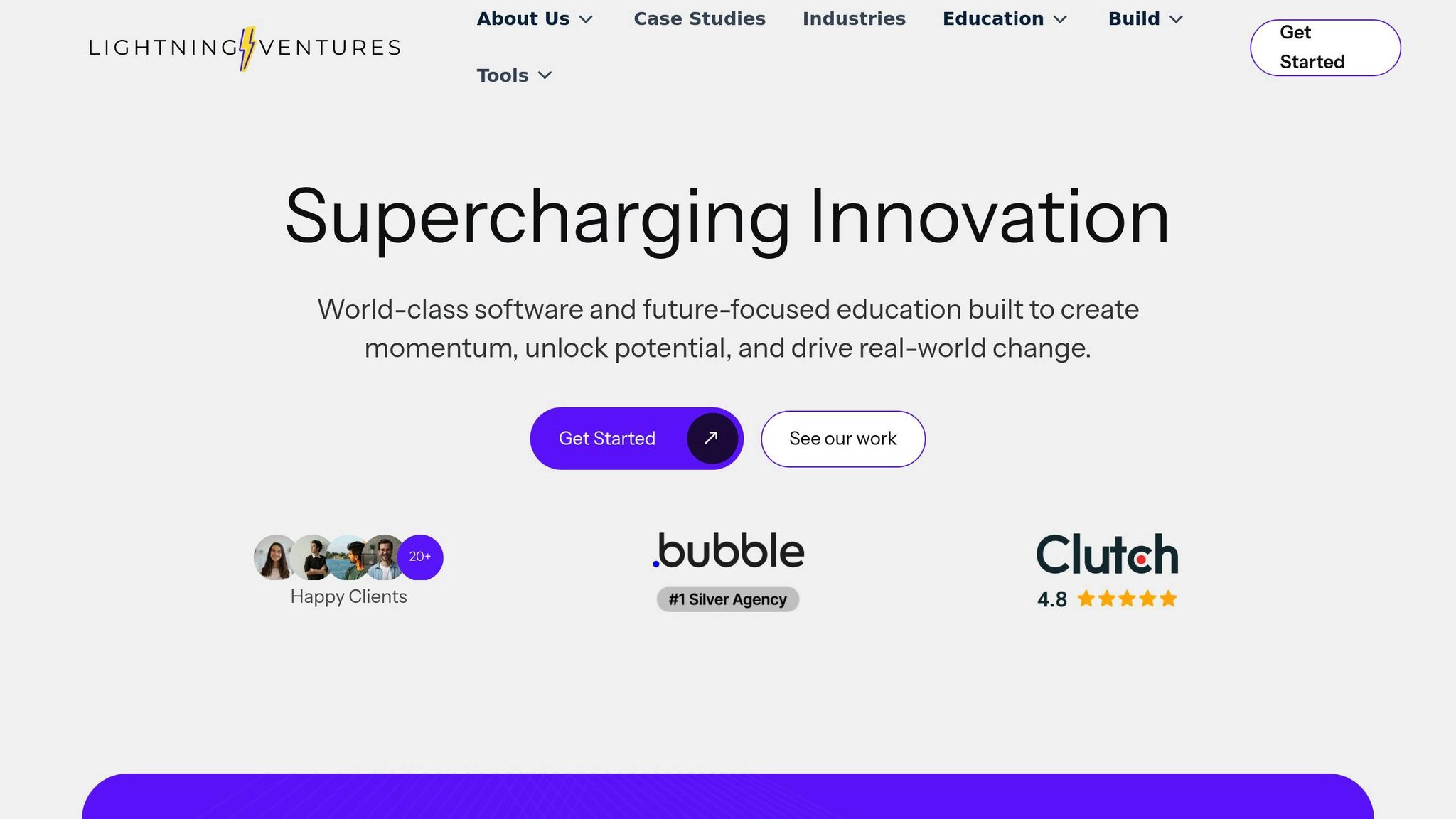%20(50%20x%2050%20px)%20(1).svg)
Building a product doesn’t have to cost a fortune or take months. With no-code tools, you can create a Minimum Viable Product (MVP) in weeks, even without technical skills. Here’s what you need to know:
No-code MVPs are reshaping how startups test and scale ideas. Whether you’re a solo founder or part of a team, this approach offers a faster, cost-effective way to bring your vision to life.

These real-world examples show how startups have harnessed no-code tools to build MVPs efficiently and effectively.

A Canadian IT security startup created a platform connecting businesses with cybersecurity experts for file verification using Bubble. With a small team, they launched a fully functional product swiftly and at a fraction of the cost of traditional development methods.
Bubble’s visual editor allowed the team to skip writing code entirely, letting them focus on testing their business model instead of wrestling with technical hurdles. Summing up this approach, one expert noted:
"For organisations aiming to validate product ideas and accelerate their market entry, no-code platforms like Bubble present a compelling alternative to traditional, time-intensive coding methods."
The platform’s built-in features - like user authentication, a responsive design editor, and database management - helped the startup create a professional, scalable product. This case underscores how no-code tools can simplify and speed up MVP development.

In another instance, a SaaS founder used Airtable to build a lightweight CRM, while another team turned to Zapier for workflow automation.
The Airtable-based CRM allowed users to manage leads, track sales progress, and automate follow-ups - all within a single system. This setup enabled quick prototyping and testing of various workflows.
Meanwhile, a team collaboration tool leveraged Zapier to sync tasks automatically with project management apps like Trello and Asana. By using Zapier’s trigger-action functionality, they avoided the need for custom integrations, freeing up resources to focus on core features.
These examples highlight a few important takeaways for startups considering no-code development:
Traditional MVP development can cost anywhere from A$30,000 to A$150,000. No-code tools offer a cost-effective alternative, enabling startups to deliver scalable, high-quality solutions while staying agile and responsive to evolving user demands.
For Australian startups aiming to validate their ideas quickly without breaking the bank, combining the Lean Startup methodology with no-code development is a game-changer. This dynamic duo thrives on rapid testing, continuous learning, and smart resource management - qualities that no-code tools excel at.
No-code platforms can deliver a Minimum Viable Product (MVP) in as little as 3–4 weeks, making it easier for startups to test high-risk assumptions early on. These tools drastically shorten the build–measure–learn cycle, sometimes to just a matter of days, allowing for faster iteration and decision-making.
With a prototype in hand, the next step is to zero in on the essentials and keep the momentum going.
A successful MVP doesn’t need to do it all - it just needs to do enough. Focus on three to five core features that will resonate with your audience. No-code platforms, with their visual interfaces and modular design, make it easier to prioritise functionality over unnecessary extras.
One effective way to decide which features to include is by using the MoSCoW method. This framework categorises features into Must-haves, Should-haves, Could-haves, and Won’t-haves, helping teams allocate resources wisely.
Take Zappos as an example. In its early days, the company didn’t launch with a fully developed e-commerce system. Instead, founder Nick Swinmurn created Shoesite.com with just the basics - uploading photos and manually processing orders. This "Wizard of Oz" MVP proved there was a demand for online shoe shopping, leading to Zappos' eventual $1.2 billion acquisition by Amazon.
Buffer, another standout, started with a simple landing page. The initial page collected email addresses from interested users, while a follow-up page tested pricing options. Once they saw that people were willing to pay, they knew their idea had legs.
By focusing on the 20% of features that deliver 80% of the value, startups can use no-code tools to get immediate user feedback and refine their product accordingly.
Customer feedback is the heartbeat of an evolving MVP. In fact, over 70% of successful startups credit their early traction to an effective MVP strategy. The key is to continuously gather and act on user insights.
EntryLevel is a great example of this in action. They harnessed no-code tools to run quick experiments based on real-time feedback. This iterative approach helped them achieve a conversion rate of 10.58%, far above industry norms. Instead of bundling updates into large, infrequent releases, they rolled out small changes every one to two weeks.
To make feedback easy to share, consider using multiple channels like in-app surveys, dedicated email addresses, feedback forms, and social media groups. Asking specific, targeted questions - such as "What task were you trying to complete when you encountered this issue?" - can uncover valuable insights that generic questions might miss.
Steadysun offers a practical example of this feedback loop. In 2021, they developed Frogcast, a weather forecasting tool for businesses, using the no-code platform WeWeb. After six months of building the frontend, they released the MVP for user testing and used the feedback to refine their product–market fit.
Centralising feedback in tools like CRMs or project management software ensures that all insights are actionable and easy to track. Regular reviews, whether weekly or fortnightly, keep the MVP aligned with real user needs instead of internal assumptions.
The real magic of no-code development lies in how quickly feedback-driven changes can be made. While traditional development might take weeks to tweak a feature, no-code platforms often allow updates to be made on the same day. This fast turnaround not only keeps users engaged but also reinforces the Lean Startup philosophy - a must for staying ahead in Australia’s competitive market.
Building an MVP (Minimum Viable Product) with no-code tools can be a game-changer, offering speed and accessibility that’s hard to beat. However, as Australian startups begin to scale, these tools can present unique challenges. Recognising these potential pitfalls early on can help you avoid costly errors and keep your product on track. Let’s dive into some common hurdles and how to tackle them effectively.
Scaling an MVP built with no-code tools isn’t always smooth sailing. What works perfectly for 50 beta testers might crumble under the pressure of 5,000 active users. You could face slow loading times, performance bottlenecks, or even system crashes as your user base grows.
To stay ahead of these issues, start performance testing early. Simulating high user loads can help uncover weak points before they escalate into bigger problems. Many no-code platforms come equipped with built-in analytics to monitor system performance - make these tools part of your routine.
Scalability planning is another critical step. Some no-code platforms are designed to handle thousands of users with ease, while others may struggle as your user count climbs. Look into your platform’s track record with similar projects and review its pricing structure for higher usage tiers. Keep in mind that the global no-code market reached $21.2 billion in 2022, and as these platforms evolve, their capabilities and costs can shift.
If optimisation efforts don’t fully resolve performance issues, consider a hybrid approach. For example, you could keep the no-code elements that work well and move performance-heavy features to custom development. This mix can give you the best of both worlds - speed for simpler tasks and reliability for complex ones.
A successful no-code MVP often relies on multiple platforms working seamlessly together. For instance, your customer data might live in Airtable, payments could run through Stripe, emails via Mailchimp, and your app hosted on Bubble. But if one of these integrations fails, your entire workflow could grind to a halt.
As your startup grows, integration stability becomes a top priority. Relying too heavily on third-party tools increases your risk if one of them experiences downtime or changes their API. It’s critical to assess which integrations are essential and have contingency plans in place.
Start by mapping out your workflow to identify bottlenecks and redundant steps. This visualisation can help you streamline processes and spot areas where automation could improve efficiency.
For more complex tasks where basic integrations fall short, consider combining no-code platforms with custom scripts. This hybrid strategy allows you to use visual workflow builders for routine tasks while leveraging custom code for more advanced operations. It’s a flexible way to handle challenges without abandoning the speed and ease of no-code tools.
When these solutions aren’t enough, it might be time to bring in external expertise.
Sometimes, the best way to move forward is to call in the experts. Many founders try to solve technical challenges on their own, only to end up with solutions that need a complete overhaul later.
Engage professionals early if you’re struggling to choose the right no-code tools or if your project’s complexity feels overwhelming. A seasoned consultant can evaluate your needs and determine whether no-code platforms can deliver or if traditional development is a better option from the outset.
Take the example of Acropolium, which developed a cloud-based purchase order system that boosted productivity by 20% and profit margins by 10%. Their success highlights the benefits of expert guidance, particularly for complex integrations.
Security and compliance are other areas where professional help is invaluable. If your MVP deals with sensitive customer data, financial transactions, or operates in a regulated industry, experts can ensure your platform meets all necessary standards.
Lastly, if your team is bogged down with technical hurdles instead of focusing on features, it’s a clear sign to seek external help. Professionals can address immediate challenges while setting up a solid framework for scaling your no-code development effectively.

Tackling the technical and scalability challenges faced by emerging businesses, Lightning Ventures offers tailored solutions for Australian startups. By addressing common MVP roadblocks, they guide founders through fast product development while helping them avoid typical pitfalls. Their expertise shines through in their development, training, and innovation support services.
Lightning Ventures transforms startup ideas into functional software within just 2–4 weeks. Their process revolves around platforms like Bubble.io, enabling them to deliver results five times faster than traditional agencies. With project costs starting at $20,000 and hourly rates from $170, they’ve positioned themselves as an accessible choice for early-stage Australian startups.
Their development strategy is structured and thorough: from collaborating on concepts and prototyping with Figma, to building on Bubble, conducting rigorous quality and security checks, and providing launch support. A 15-point security checklist and Flusk monitoring are integrated into their workflow to ensure reliability and safety.
One standout project is Hey Juno, a global AI research platform that connects researchers with real people to gather and analyse human insights.
Jian Wei Hoh, Founder and CEO of VIIZR, a Ford-backed company in Silicon Valley, shared his experience:
"The Lightning Team are real hustlers with lived startup experience. They helped us get up and running quickly!"
Beyond development, Lightning Ventures empowers non-technical founders with practical, hands-on no-code workshops. These training sessions have reached major startup hubs across Australia, from Melbourne to Sydney.
In January 2025, they partnered with RMIT Activator Founders, delivering live no-code workshops that accelerated MVP development and boosted founder confidence. Participants gained practical skills through live demonstrations rather than passive, theory-heavy presentations.
Steph Chan, Delivery Lead at RMIT, praised the workshops:
"Lightning Products delivered an incredible in-person workshop for our Activator Founders, diving deep into NoCode tools, startup strategies and MVP Development. We have many non-technical founders who are unsure of their options to build and ultimately launch their MVP. Dave gave our founders the practical skills through live demos, their approach made complex concepts easy to grasp, and the energy in the room was electric."
For those seeking a deeper dive, the Lightning Accelerator programme offers an 8-week intensive course. Matt Woodward, Founder of Scalr, shared his experience:
"The Lightning Accelerator was incredible. It helped me take my idea and build it in Bubble.io within 8 weeks. I learned so much about the fundamentals of building software. It was empowering as I've been a tech recruiter sitting on the sidelines for so many years. Would recommend it to anyone trying to launch their own business."
Lightning Ventures’ influence extends across Australia’s startup ecosystems. In January 2025, they collaborated with the Western Sydney Startup Hub, speeding up product development, improving onboarding processes, and implementing smarter growth analytics.
Caroline Lepron from Western Sydney Startup Hub highlighted their impact:
"Lightning Products ran an awesome product workshop on the power of NoCode tools. The founders got a lot out of the sessions and there were tons of actionable ideas on how to get started and launch your MVP."
Their work with the Melbourne Accelerator Program showcases their ability to scale education across diverse founder groups. Marina Chelak, Program Coordinator at Melbourne University’s Melbourne Accelerator Program, noted their effectiveness:
"Lightning Products were awesome to work with. They ran an amazing webinar which helped our founders understand the power of NoCode and how they can quickly validate and get their ideas off the ground. Would definitely recommend them to others."
Collaborations with communities like Fishburners and Climate Salad further illustrate their expertise. For Climate Salad, Lightning Ventures streamlined workflows, saving two hours per week and improving community signups.
Through their work with university accelerators, co-working spaces, and startup hubs, Lightning Ventures has established itself as more than just a development agency. They’re reshaping how Australian founders approach MVP development, making software creation accessible for non-technical entrepreneurs.
Examples from the real world show how no-code tools are transforming entrepreneurship in Australia. Whether it's creating marketplace platforms or AI-driven learning systems, these tools are reshaping how founders tackle product development. Building on earlier case studies, here's why no-code MVPs are a smart move for Australian startups.
Traditional development teams can take anywhere from 4 weeks to 9 months to build an MVP. In contrast, no-code platforms can cut that timeline down to just a few days. This speed gives startups a clear edge, with 65% of companies choosing low-code solutions to get to market faster.
Cost is another major factor. By using low-code platforms, 87% of enterprises report lower development costs. Many no-code tools are budget-friendly, with free basic plans and premium features starting at just $10-20 per month. For Australian startups working with limited resources, this makes product development much more accessible.
Flexibility is also a standout benefit. Take Comet, a marketplace for freelance IT professionals built entirely on Bubble. Since launching in 2016, they’ve raised over €14 million in Series A funding and partnered with more than 1,000 companies. Their ability to quickly adapt to user feedback and market needs has been crucial to their success.
Reid Hoffman, co-founder of LinkedIn, summed up the no-code philosophy well:
"If you aren't embarrassed by the first version of your product, you shipped too late."
This approach aligns perfectly with no-code tools, where rapid development and constant iteration are part of the process.
Many successful founders lean on expert advice to maximise their results. Dani Bell’s journey with Scribly.io is a great example. Using tools like Zapier, she built a content marketing agency that reached $30,000 MRR before selling it in 2021, just two and a half years after launching.
Yet, as no-code ecosystems grow more complex, expert guidance becomes increasingly valuable. Gartner's research predicts that by 2025, over half of low-code users will be non-technical. This means there’s often a gap between what the tools can do and what users know how to achieve.
Consider the impact of the right support. RentFund, created with Glide, gained significant investor interest and hit a $3 million valuation, all while cutting payment processing times by 50%. Similarly, BarEssay used Bubble to launch an AI-powered learning platform in just four weeks. Students reported 30% less study time and 70% better targeting of weak areas.
Expert advice dovetails with lean startup principles, especially as 60% of managers surveyed by KPMG view low-code development as "critical to very critical" for future success. Getting implementation right can make all the difference.
For Australian entrepreneurs, the next move is to focus on strategic implementation. Start by setting clear goals and defining essential features before jumping into development. Trying to build everything at once can derail even the best ideas.
Choosing the right platform is equally important. As the case studies show, the right tool depends on the project - Bubble works well for complex apps, Glide is ideal for mobile-first solutions, and Zapier excels at automation.
User feedback should be part of the process from day one, not an afterthought. Pieter Levels demonstrated this with Nomad List, starting with a basic MVP in Google Sheets to test demand. That simple start grew into a platform serving over 6 million annual users.
For Australian startups, the timing couldn’t be better. With nearly half of IT leaders expected to adopt low-code or no-code technologies by 2025, early adopters stand to gain a significant advantage. The mix of accessible tools, proven strategies, and expert support has created a powerful environment for startup success.
The message is clear: no-code MVP development is no longer just an option - it’s becoming the go-to method for Australian entrepreneurs looking to efficiently build, test, and grow their ideas.
Using no-code tools to develop an MVP comes with several standout benefits compared to traditional coding approaches.
For starters, it’s much faster. With no-code platforms, startups can roll out their products in a fraction of the time it would take with conventional coding. This quick turnaround is essential for testing ideas and adapting to customer feedback on the fly.
Another big win is cost savings. These tools cut down the need for large, specialised development teams, making them a budget-friendly option - perfect for startups that need to make every dollar count.
Lastly, no-code tools offer unmatched flexibility. Non-technical founders can make changes and updates themselves without waiting for a developer. This ability to pivot and tweak things quickly is a game-changer during the early stages of building a product and figuring out what works in the market.
Startups can address scalability and performance hurdles on no-code platforms by choosing tools specifically built to support growth. Look for platforms with strong scalability options and comprehensive full-stack features. These ensure your app can handle higher data volumes and user activity without slowing down or breaking under pressure.
To keep things running smoothly as your business grows, it's also critical to conduct regular performance testing. Pair this with optimisation strategies like simplifying workflows and cutting out unnecessary steps. By focusing on these practices from the start, you can ensure your no-code solution stays dependable and efficient, even as your startup expands.
Non-technical founders can bring their no-code MVP to life by following a few focused strategies. Begin by pinpointing the main problem your product addresses and defining the must-have features for your MVP. This approach keeps the development process simple and ensures you're prioritising what’s truly important.
Select a no-code platform that aligns with your product’s requirements, budget, and future growth plans. For example, platforms like Bubble are highly flexible for creating custom apps and automating workflows. If you're feeling stuck, reaching out to experts or joining no-code workshops can provide clarity and direction.
After building your MVP, share it with early users, gather their feedback, and make improvements quickly. This cycle of testing and refining will help confirm your idea and fine-tune your product for a strong launch in the Australian market.